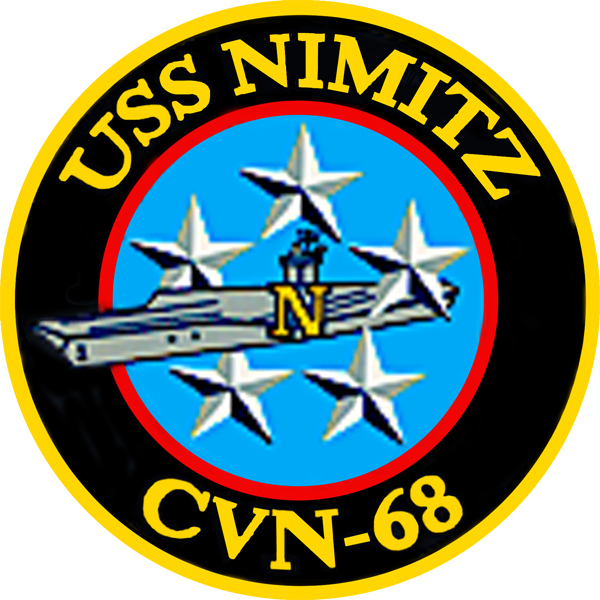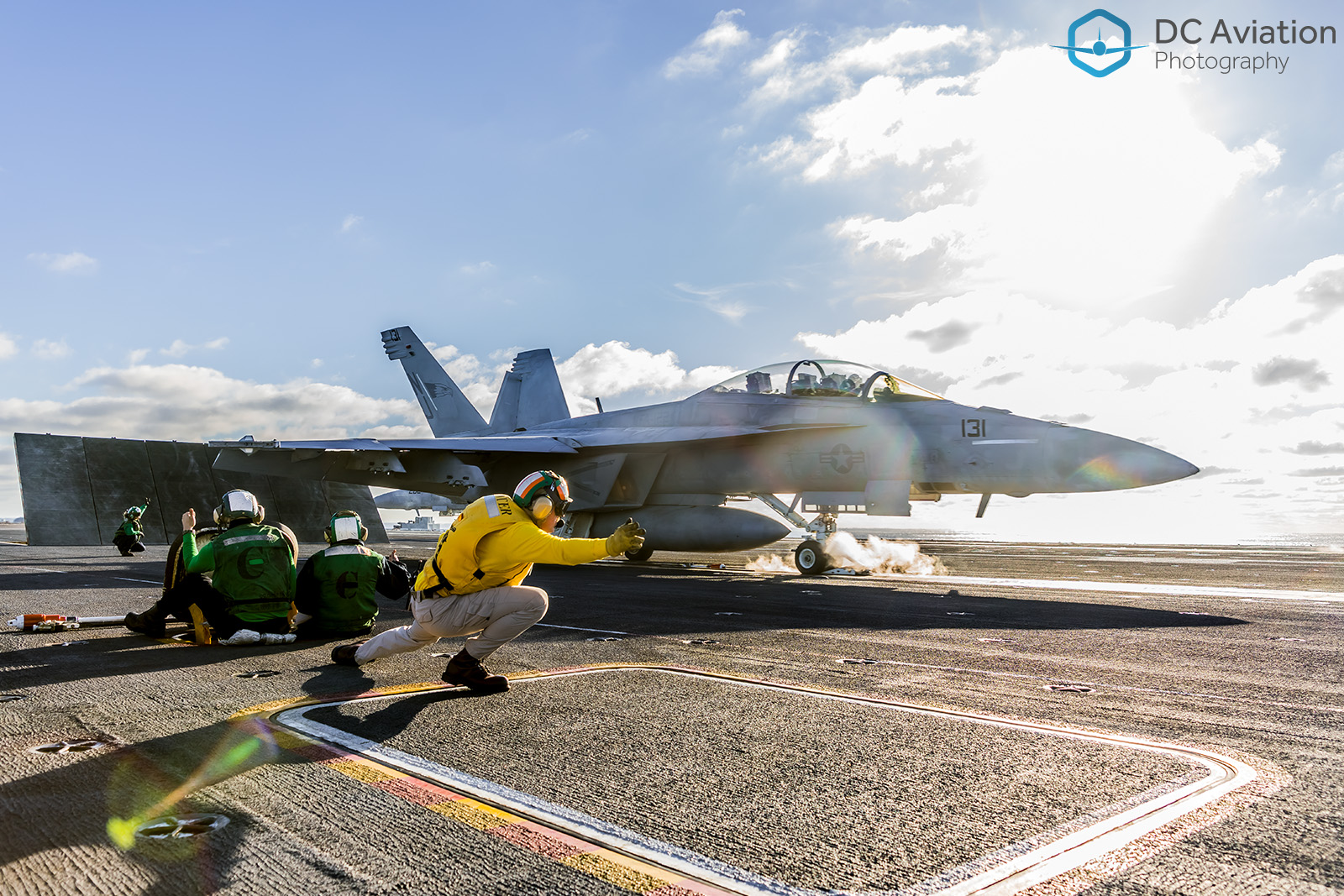The USS Nimitz is the first carrier of the “Nimitz Class”, which got named after the first ship of its’ class, the USS Nimitz. It is one of the largest aircraft carriers in the world. The so-called “supercarriers” dominate the world’s oceans for decades and are the US Navy’s most important weapon. The aircraft carriers enable the US government to react quickly and flexibly to crises all over the world.

MISSION “Carrier Qualification”
January 2020, the USS Nimitz with its two 30-ton anchors has just left the Naval Air Station North Island in Coronado (San Diego). Today it is going on a special trip out to the Pacific Ocean.
The hangars as well as the flight deck are still almost empty. This has a special reason: The USS Nimitz was at her home port in Everett over Christmas and came to San Diego only a few days ago to resume after the “Christmas vacation”.
The mission for the next few days is clear. This time we are not going on a dangerous voyage to fix the world’s trouble spots. This Saturday, pilots will land on an aircraft carrier for the first time in their lives. It’s called “Carrier Qualification”, in which pilots get their badge to be allowed to land on aircraft carriers like the USS Nimitz in the future.

Weeks in advance, landing-exercises were carried out at various locations, such as NAF El Centro, to prepare the pilots for an aircraft carrier landing. For their first carrier-landings, it is important that the pilots get some space on the flight deck, so there is no high activity on the deck this weekend. The safety of the seamen and of the future carrier pilots is the top priority. For the safety of the pilots, the rescue helicopters of the type MH-60R, the HSC-6 ” Indians Insignia” circle around the ship in order to be able to rescue the pilots from the sea as quickly as possible in an emergency situation.
A “Carrier Qualification” is always something very special for pilots, everyone wants to give their best and hit the catch rope at the first attempt. Landing on a floating ship during this difficult maneuver requires a high level of concentration and skill to complete the task. On this day, six pilots had the opportunity to complete their carrier qualification. Around 2 pm the jets took off from the mainland of the US towards the USS Nimitz and prepared for the first landing. The captain turned the ship around to create good wind conditions for the jets and maneuvered the ship into a calm fairway. An almost two-hour practice phase began, and the pilots tried to complete their first approaches safely.

Thanks to the intensive exercises on land, they knew exactly what to expect and how to react in case of a mistake. The pilots were highly concentrated, because they knew that a too fast approach or a wrong descent could be fatal. As soon as the pilots noticed that they were not exactly on course, they’ve set full thrust and performed a go around. Missing the safety lines can also be very risky, so the pilots set full thrust shortly before touchdown to have the necessary power to perform a go around maneuver. The first approaches were made and with a hit rate of 60% the pilots can be very satisfied.
As soon as the pilots had landed, they swapped places with each other and immediately rolled back to the launch catapult. Takeoff – with an acceleration of 2.5s to 250 km/h they took off again and the pilots did an airfield traffic pattern and prepared for the next approach. Shortly before sunset the session ended, and the pilots could recover a little. But the day was not over yet. After dinner, below deck everyone prepared for the most demanding part of the mission – Night landings.

The pilots probably did not notice the fantastic night sky with many stars at all. Their eyes were only focused on the few auxiliary lights of the Marshalls to get safely to the launch catapult. They took off again with an indescribable acceleration. On the ship you could feel the tension of all soldiers and it became quiet. All possible disturbing factors like camera lights or conversations had to be avoided to not distract the pilots. The night landings on an almost unlit runway on the high seas is the supreme discipline of the whole qualification. The almost one-hour-lasting flight phase started, and the first jets turned into the final approach. With the naked eye the catching ropes were hardly visible, but the pilots managed to land the jets safely. Although there were some go around maneuvers, everything went smoothly and at the end of the day five pilots were happy to have reached the qualification. The sixth pilot got another chance the next day to prove his skills. All six jet pilots were very well prepared by the weeks of training. On this day the week-long training paid off, because in about 60% of the landings the catch rope was caught on the first attempt, the rest were touch-and-go-landings and go around maneuvers, where the rope was not hit on the first attempt.
The USS “Nimitz”
The USS Nimitz, with the code CVN-68, is the first aircraft carrier of the Nimitz class of the United States Navy.
The ship code (CVN-68) is composed as follows:
“CV” is the classification symbol for aircraft carriers, while “N” indicates that it is nuclear-powered. The “Nimitz” is the 68th of her kind in the U.S. Navy, and the carrier’s home port is Naval Base Kitsap in Washington. The 4.5 billion, nuclear-powered “supercarrier” was named after the legendary Fleet Admiral Chester W. Nimitz (1885-1966), who helped the United States defeat the Japanese in World War II.

The USS Nimitz was put into service in 1975 and is expected to be replaced in 2022 by a Gerald R. Ford class aircraft carrier, the USS John F. Kennedy with the code (CVN-79). The “Nimitz” is the first of ten nuclear-powered aircraft carriers of its type. It reaches a maximum speed of 35 knots and is one of the largest in the world.
It is the flagship of the Carrier Strike Group Eleven (CVW-11) with an embarked Carrier Air Wing Seventeen (CVW-17), which is equipped with fighters, reconnaissance aircraft, transport aircraft and helicopters of the types F/A-18E/F “Super Hornet”, F-35C “Lightning”, EA-18G “Growler”, E-2C “Hawkeye”, C-2A “Greyhound” briefly called “COD” and the MH-60S/R’s “Seahawk”. The supersonic jets, which cost about 70 million dollars, are catapulted from 0 to 250 km/h within four seconds with a deafening bang. The catapult takes the generated steam from the ship’s nuclear reactor to catapult the jets. A total of 65 to 70 aircraft are on board at full operational strength, and they embark on their combat or training missions on the 4.5-hectare flight deck.

The USS Nimitz is home to around 2800 people who look after the ship 24 hours a day. In addition, up to 2000 people from the “Carrier Air Wing” take care of the aircraft.
The “Supercarrier” with its nuclear reactor can stay at sea for about 20 years until the fuel rods have to be replaced. Thanks to the space-saving nuclear energy, the ship can carry 50 percent more ammunition and almost twice as much kerosene for supplying the aircraft – that is a total of 3.5 million gallons of jet fuel. The aircraft carrier can store refrigerated and dry goods for 70 days and is supplied by a supply ship when deployed at sea. The current commanding officer of the “Nimitz” is Captain Max Clark.
The backbone of the supercarrier
Without the strong men and women on the ship, it would only be a 97,000-ton floating steel colossus without function. The crew is the core of all operation taking place there. The average age of the crew is just 25 years, so there are mainly young seafarers on the ship, such as 21-year-old Cassie Calderonsilvestre, who, among other things, controls the supercarrier on the bridge, the heart of the ship. Besides Captain Max Clark, other important navigators and officers work here. They always ensure that the ship sails in a safe sea area.

Photo: Christian Preinl
On the aircraft deck of the “Nimitz” there are numerous teams responsible for a wide variety of tasks on the deck. The teams can be distinguished by colorful vests and work hand in hand with each other.
The entire scene, which is also called “choreographed ballet” by the crew, is guarded by sailors in white jerseys. Together they ensure that everything runs smoothly on the flight deck. Among other things, green jerseys operate the Jet Blast Deflector (JBD) – the protective walls that are raised behind the aircraft before the aircraft can take off. Aircraft handlers and shooters wear yellow jerseys. Blue jerseys work in the hangar bay and purple jerseys are responsible for refueling the aircraft, while red jerseys are responsible for flight regulations, armament and ammunition of the jets, as well as recovery in case of crashes.

Our visit on the flight deck was supervised by the “shooter” Lt. Amy Blades. Normally she gives the command to catapult the jets for take-off, but on this day she is responsible for our safety on board the “Nimitz” and guides us through this extremely dangerous environment, which is, according to the ship’s crew, one of the most dangerous places in the world. The whole scenario on the flight deck seems chaotic, but every crew member on the flight deck knows his tasks.
Indispensable, the supercarrier’s jets
Landing on an aircraft carrier is not an easy task, it takes weeks of practice, only the best pilots in the Navy will have be allowed to have this experience.
There are four special characteristics that aircraft need to have in order to land on a supercarrier: The tail hook, the structural strength of the aircraft, the reinforced landing gear and finally the retractable wings of the jets.

The tail hook, which grips the catch rope during landing, ensures that the aircraft comes to a halt on the flight deck. It must be able to withstand the high loads during abrupt braking. At the same time, it must withstand full engine power, since the aircraft must give full thrust immediately after touchdown so that it can take off immediately if the arrestor cable is missed. The structurally strengthened jets must be able to withstand catching and launching forces. The reinforced landing gear with its oversized wheels must be capable of absorbing the impact when landing on the flight deck. The wings of the jets must be foldable to save space during parking and taxiing.
All these special features increase the weight of the aircraft, allowing aircraft carrier jets to fly slower and not as far as Air Force jets. Aircraft Carrier Jets or also called CVN jets, but due to the carrier they have the characteristics, that they can move all over the world and therefore do not have to cover too large distances.

The mission of an aircraft carrier is to support and operate aircraft that carry out attacks on targets in the air, on water or on land that threaten the free use of the sea; and to participate in sustained power-projection operations in support of U.S. and coalition forces.
With a nuclear-powered aircraft carrier, the U.S. Navy has unsurpassed superiority in wartime operations. Since the ship does not require any additional fuel, it is operational around the clock. Mission duration and flexibility are hallmarks of a nuclear aircraft carrier. The aircraft carrier has the decisive advantage that it can move freely on the open sea. The jets can quickly and effectively conduct combat missions over 1000 nautical miles with in-flight refueling. The ship itself can move on the sea for weeks without supplies of food, ammunition or jet fuel.


